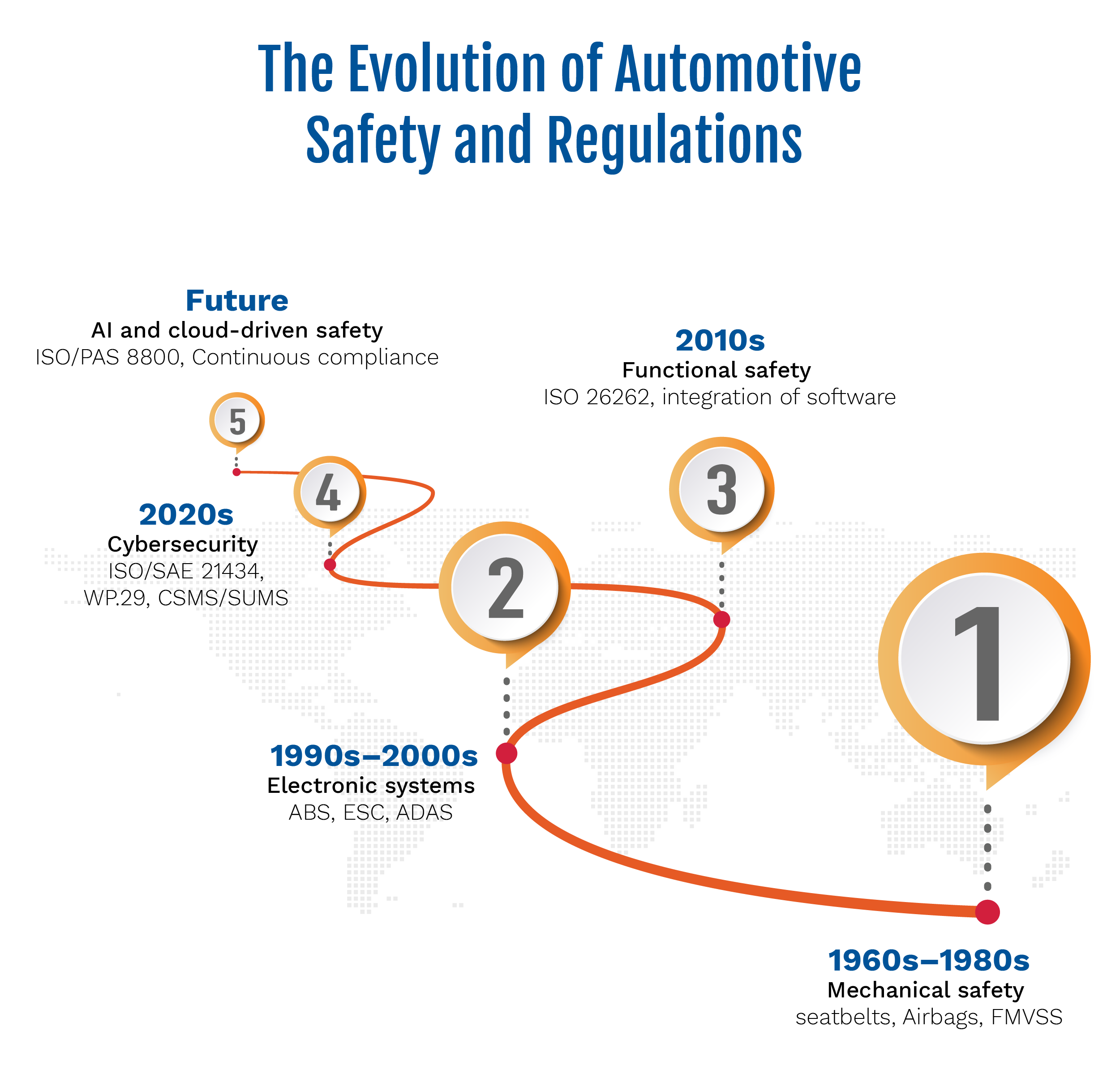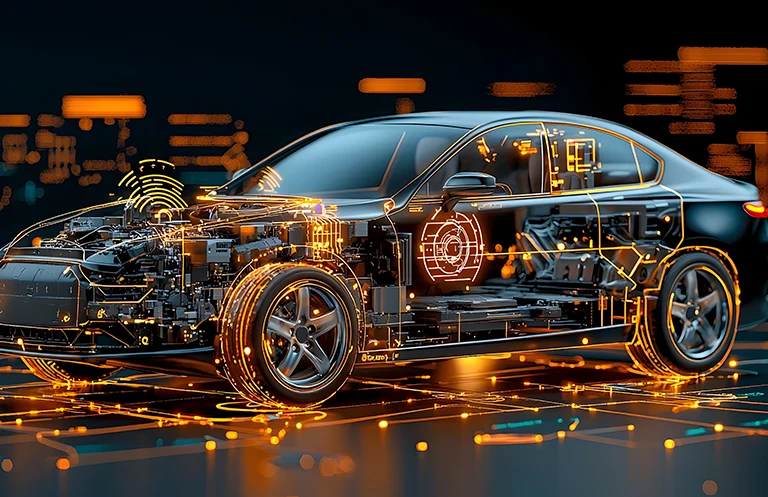The automotive industry is currently experiencing its biggest transformation in over a century. Where cars were once defined by their mechanical parts and engine power, they revolve around software and connectivity today. This transformation has resulted in exciting innovations.
However, it has also introduced some new challenges, particularly around safety and cybersecurity. Automotive regulations had to adapt quickly to keep pace with modern, software-driven vehicles (SDVs).
In this blog, we explore how these automotive regulations have changed over the past few years, from simple laws aimed at physical safety to the more comprehensive, complex standards that focus heavily on software and cybersecurity.
What is Automotive Engineering
Automotive engineering is a field that focuses on the design, development, testing, and production of automobiles. It blends various aspects of mechanical, electrical, electronics, software, and safety engineering to create cars and other automobiles. Engineers in this area work to improve how vehicles perform, how safe they are, and how efficiently they run. They are also responsible for making sure vehicles adapt to the new advances, such as automation, connectivity, and electrification. With the automotive industry rapidly evolving, automotive engineers are helping shape the future of transportation by moving beyond just mechanical systems and embracing intelligent, software-driven vehicle technology.
From Seatbelts to Sensors: How It All Began
During the mid to late 20th century, automotive safety regulations focused on protecting passengers in the event of crashes. Government bodies introduced laws like the Federal Motor Vehicle Safety Standards (FMVSS) in the U.S. and the Euro NCAP testing protocols in Europe. These rules focused on passive safety features such as seatbelts, airbags, and crumple zones. They set essential safety standards that pushed car manufacturers to build safer vehicles. Back then, electronics and software played a very minor role, most safety measures were mechanical, centered on how the car’s structure responded during impacts.
The Electronics Revolution and Functional Safety in a Nutshell
In the early 1990s, vehicles began integrating more advanced electronics. Advanced features like anti-lock braking systems (ABS), electronic stability control (ESC), and advanced driver-assistance systems (ADAS) have changed the vehicles from mechanical machines into sophisticated electronic platforms. This transformation introduced a new risk: system failures could now happen because of software or hardware glitches, not just mechanical faults.
To address this challenge, the automotive industry introduced ISO 26262, an international standard for functional safety focused on electrical and electronic systems in vehicles. This standard provides a framework to identify potential hazards in vehicles, set safety integrity levels, and manage risks throughout the vehicle’s lifecycle. This marked a tremendous shift toward making automotive safety an integral part of how vehicles are embedded, engineered, and built.
Addressing Cybersecurity Challenges
As vehicles became increasingly connected with features like infotainment systems, vehicle-to-everything (V2X) communication, and over-the-air (OTA) updates, the threat of cyberattacks grew. The connectivity permits features but it also allows hackers to gain remote access to vehicles and compromise safety-critical functions, elevating cybersecurity risks and privacy concerns to a top priority.
To address this emerging risk, new regulations were introduced. ISO/SAE 21434 sets the guidelines for cybersecurity in road vehicles. On top of that, UNECE WP.29 requires OEMs to implement Cybersecurity Management Systems (CSMS) and Software Update Management Systems (SUMS) in place for vehicles sold in member countries. Together, these standards transform automotive safety from a reactive to a proactive approach, focusing on preventing cybersecurity risks before they happen.
Evolving Regulatory Landscape
Today, automotive regulation involves more than just a single standard. It is a web of interconnected regulations and industry best practices, including:
- ISO 26262: For road vehicles and functional safety
- ISO/SAE 21434: For automotive cybersecurity risk management
- UNECE WP.29: For harmonization of vehicle regulations and global type approvals
- Automotive SPICE (ASPICE): For automotive engineering and software development processes
- AUTOSAR (Automotive Open System Architecture): For automotive embedded systems
- MISRA C: For safe coding practices in critical software
This integrated framework means that not only car makers (OEMs), but also Tier-1 and Tier-2 suppliers need to follow safety and security measures right from the start of their development work.

Regulatory Challenges Raised by Innovation – Breaking or Making Futures?
While compliance may seem daunting, many industry leaders are transforming compliance risks into competitive advantages. Aligning with regulations helps them identify areas for improvement in product quality, reduce the rise in product recalls, expand their customer base, and build trust with customers. Plus, many frameworks promote modular design crafting reusable and interchangeable components, helping companies scale effectively across different vehicle platforms.
Looking Ahead
As technologies like AI-driven autonomous vehicles, and cloud services become fundamental parts of vehicles, future regulations will need to adapt again. We can expect new rules around real-time compliance monitoring, AI software certification, and ongoing cybersecurity assurance during a vehicle’s entire lifecycle. Early efforts like ISO/PAS 8800, a standard focused on the safety for AI-driven systems in road vehicles, hint at the exciting changes ahead.
Conclusion
Automotive regulations have come a long way, from simple rules about seatbelts and crash safety to sophisticated frameworks governing complex software and cybersecurity systems. This evolution mirrors how vehicles themselves have transformed into software-defined, connected machines. For everyone involved in automotive development, OEMs, and suppliers alike, understanding and mastering this regulatory landscape is no longer just a legal requirement; it is a key driver of innovation, safety, and success in the age of the software-defined vehicle.











